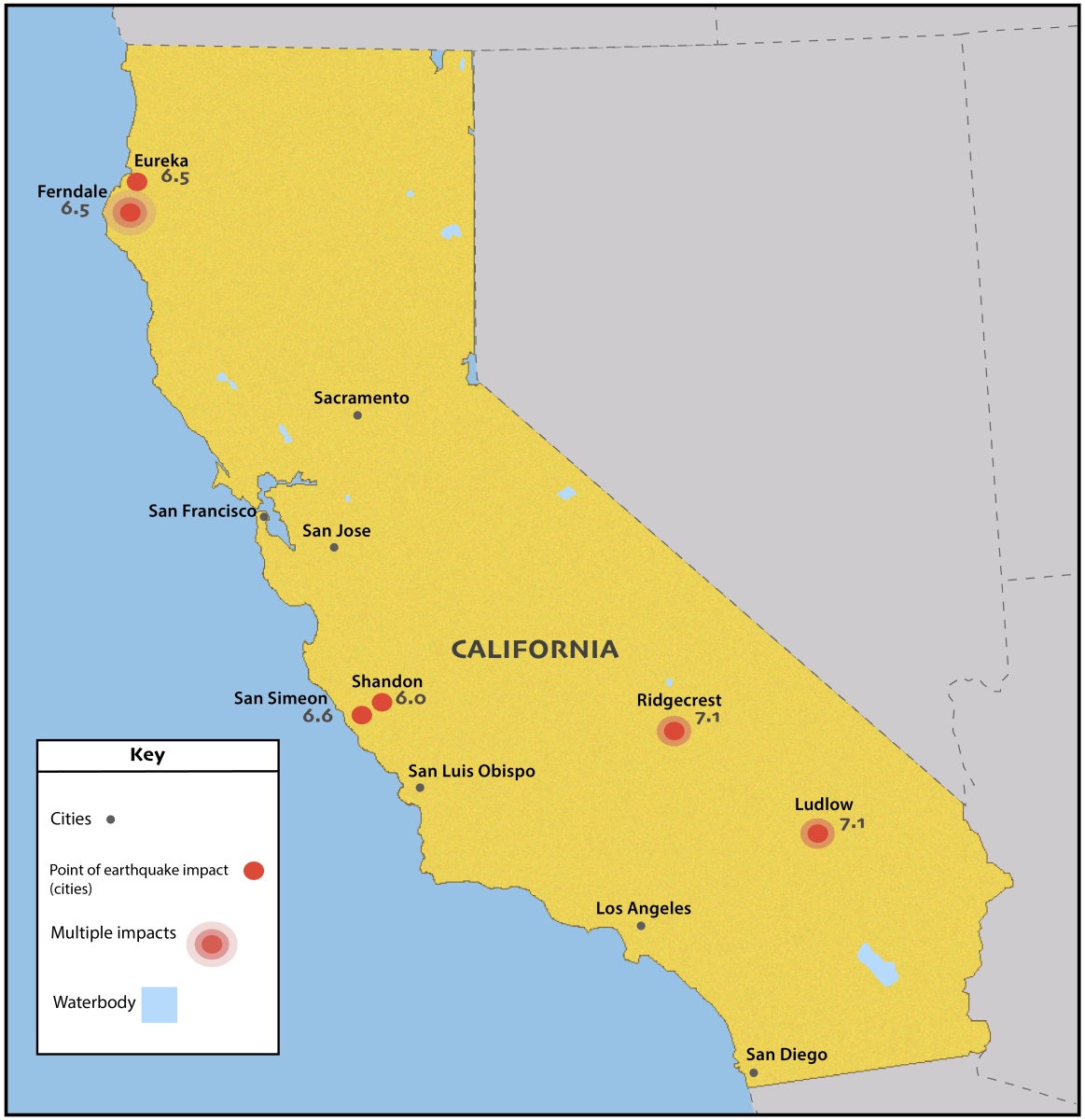The state of California is home to the San Andreas fault, a marker for constant land movements resulting in the shockwaves we call earthquakes.
The San Andreas fault is among many earthquake faults in California. Some cause swinging objects while others have the power to destroy buildings.
Here are the 10 largest earthquakes that California has experienced in the last 20 years.
10. Ferndale, Calif. (05/22/15) 5.7
This earthquake caused a lot of shaking and panic, but no casualties or severe damage was reported.
9. Ludlow, Calif. (10/16/1999) 5.8
In 1999, Ludlow experienced a 7.1 earthquake, followed by several aftershocks. The highest was a 5.8. Â
8. Ferndale, Calif. (02/04/2010) 5.9
On February 4, 2010, a 5.9 earthquake struck offshore just a month after a much larger earthquake hit the area. Thanks to its distance from any major city, very little damage was caused and there were no casualties.
7. Shandon, Calif. (09/28/2004) 6.0
Little data exists on this earthquake. Intense shaking was reported, as well as moderate damage, but no casualties.
6. Ridgecrest, Calif. (07/04/19) 6.4
The Ridgecrest earthquake occurred just after 10:30 a.m. on Independence Day. The earthquake struck a small town that had little media coverage before the event.Â
5. Eureka, Calif. (01/10/10) 6.5
An offshore earthquake recorded at magnitude 6.5. No casualties or serious injuries were reported.
4. Ferndale, Calif. (12/08/16) 6.5
This earthquake was recorded offshore. No casualties or significant damage was noted.
3. San Simeon, Calif. (12/22/03) 6.6
Number three on the list is located in SLO county. The 2003 earthquake severely damaged 46 structures and took two lives.
2. Ludlow, Calif. (10/16/1999) 7.1
Known as the Hector Mine earthquake, this 7.1 tremblor was located in a remote location. Minor damage was caused, and four injuries were reported from a derailed (but not toppled) train. The shaking went out as far as Phoenix, Ariz.
1. Ridgecrest, Calif. (07/05/19) 7.1
When an earthquake hit on July 4 in Ridgecrest, people were told that there was a small chance that it could be followed by another. The warning came true in less than 36 hours. The massive earthquake originated north of Los Angeles and was felt in the San Francisco Bay Area. Â
Advancements in earthquake technology
Advancements in earthquake technology began in the early 1900s. Architect Julia Morgan’s designs held strong against powerful earthquakes. Her long list of achievements includes Hearst Castle, which she was commissioned to do 100 years ago, and remains standing despite the powerful San Simeon earthquake in 2003.
Structures in this state look very different than on the east coast, where most buildings are built with brick. Because of this, California buildings are far more resilient to earthquakes. Â
With earthquakes, there is always a possibility of tsunamis. Over 80 tsunamis have been recorded in California’s history, with the most recent being in 1964.
Much of the advancements regarding tsunamis involve detection and warning systems. Deep-ocean and Assessment Reporting (DART) sensors are placed on the ocean floor to detect tsunamis. In addition to these, most populated coastal areas have warning sirens.
Tsunami warnings can be issued minutes beforehand and could potentially save a large number of lives. However, while warning signs appear minutes before a tsunami hits, they only come seconds before an earthquake. Â
It is much harder to give an earthquake warning before the earthquake occurs. Tsunamis have visual clues, such as receding water, sudden swells, and a giant wave. In addition to that, they often follow earthquakes. Â
Earthquakes have few visual clues. They can trip a seismograph, and the shaking starts seconds later.
It takes much less time to get to safety from an earthquake than it does a tsunami. A few seconds of warning can provide enough time to get cover.
California Integrated Seismic Network (CISN) is set up to detect earthquakes and notify people as soon as one is detected. The website warns that when an alert is received, it is not a warning and shaking will follow. Â
Currently, earthquakes cannot be predicted in advance like most other natural disasters. Â
Earthquakes have always been a part of the earth. With them, powerful earthquakes continue to strike but without them, humanity could cease to exist.









